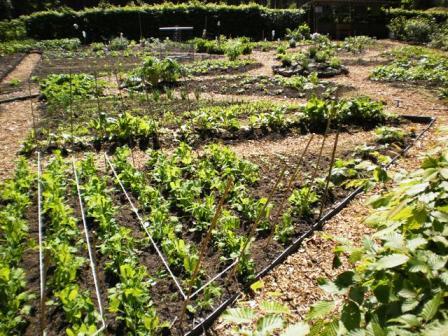 In the garden culture various crops, especially vegetables are grown. (Also, ornamental, fruit, nursery stock and mushroom growing belong to this section.)
In the garden culture various crops, especially vegetables are grown. (Also, ornamental, fruit, nursery stock and mushroom growing belong to this section.)
Arable or field culture works in the open ground, on a large-scale and with many machines (and in monoculture). Many crops are cereals, corn, flax, beet and potatoes.
Increasingly garden crops are also grown widespread and machined in agriculture: leeks, carrots, beans...
Fruits that we eat are usually food stocks that plants produce to survive or to give their seeds a survival package: carrots, beets, turnips, potatoes, apples, tomatoes, nuts...
A meat eater consumes about 8 times more farmland than a veggie.
Green food that is enough for 5 people, is through the conversion into meat adequate but for one person.
Vegetarians would have better endurance. Tough rascals.
Starting with a (small) garden
A garden requires a lot of work.And what to do with 20 pounds of radishes? Take it easy.
Don’t gos traight plowing , digging or milling 200 m, to establish after half a year that you cannot master the job. Or that you have too many vegetables.Start small,with a piece of 3 x 3 or 3 x4 meters.If it suits you can expand each year with food that you use frequently.Meanwhile, you already know a bit what you're getting into, and you have some experience with weeds, insects etc.. Related <Self-sufficient on m².>
Root crops are initially slow growing crops which thereby especially in an early stage have competition from weeds: potatoes, beets, carrots, turnips, onions, beans.... The intensive weed control was done with hoe and chop.
Many crop varieties are in the course of time lost for various reasons.
• Social impact: people wanted not (more) to be associated with food of paupers & peasants,
• economic: cultivation was too labor-intensive and / or expensive
• technical: some crops can be sown or harvested mechanically, others do not.
• selection or evolution: growers prefer species that are resistant to viruses, diseases, pests, so not resistant varieties are lost.
All vegetables are available in various varieties, early and late, smooth or curly, green (white) and sometimes red. (Not only for peppers, also carrots, cabbage, lettuce, broccoli, bean...)
Also berries (small fruit) (red currants, blackberries, raspberries, josta berries (black x gooseberry), black currants, strawberries, raspberries, kiwi, grape, blueberry, blueberry, cranberry, Amelanchier, bearberry, dogwood, blackthorn, gooseberries, blackberries,...) can in the vegetable garden. Even fuchsia berries are edible.
Birds also lusts berries. And the red color they see from afar. You could make a canopy with (strawberries) nets. Make sure that it everywhere is closed properly, otherwise the cap acts like a bird trap. Sometimes they even go down sit on the net to pick up the fruits.
The European blueberry or bilberry(Vaccinium myrtillus) is a perennial from the heather family (Ericaceae). The billow twigs are green and do not exceed 60 cm. The blueberry colors your lips and hands blue. You can process them in all kinds of preparations. On a walk I was told that the stalks remain green and have leaf green effect, so the bush can already start photosynthesis and take some lead already under leafless leafy trees early in the spring, even before the bush makes leaves.*
The blue berry (highbush blueberry, North American,) Vaccinium corymbosum) is commercially grown on a large scale. She blooms in bunches. The shrub can grow up to 2 meters high. The berry is sweeter and has white flesh and non-coloring (releasing, staining) juice, while the bilberry has red flesh and colors. The berries, like grapes, have a white layer of wax. They are thicker than the bilberry.
The red berry (Vaccinium vitis-idaea, also foxberry - Lingonberry, Cowberry, Mountain Cranberry), is rather rare, but also occurs here in the Limburg Kempen (Campine). The redberry is evergreen (keeps it leafs). The bushes remain low. Debris grow per + -5 at the end of a stem. They are sour in taste and are mainly used for making jam or cakes. Hybrids exist (but little).
Pome fruit (apple and pear, quince, medlar, hawthorn, Amelanchier) and stone fruit (e.g. plum and cherry, apricot, nectarine) can also have a place as low - or half-standard in a large garden.
(Fruit) tree planting and pruning can be found under <Tree nursey >.)
* Common broom ( Cytisus scoparius) also has leaf green in the branches, so it can convert carbon dioxide from the air into sugar even without leaves. He also always finds water with his profound taproot. The flowers in the bud are edible (salads, tea, wine) and taste like mild sweet peas. The shrub is slightly poisonous and contains sparteine (a quinolizidine alkaloid that stimulates the heart, circulation and intestinal function).
Aspen leaves (Populus tremula) shiver and turn audibly with every breath of wind. It does not bother them: the aspen is the only tree that can do photosynthesis with the top and bottom of the leaf. Other trees use the bottom of the leaf for breathing only.
